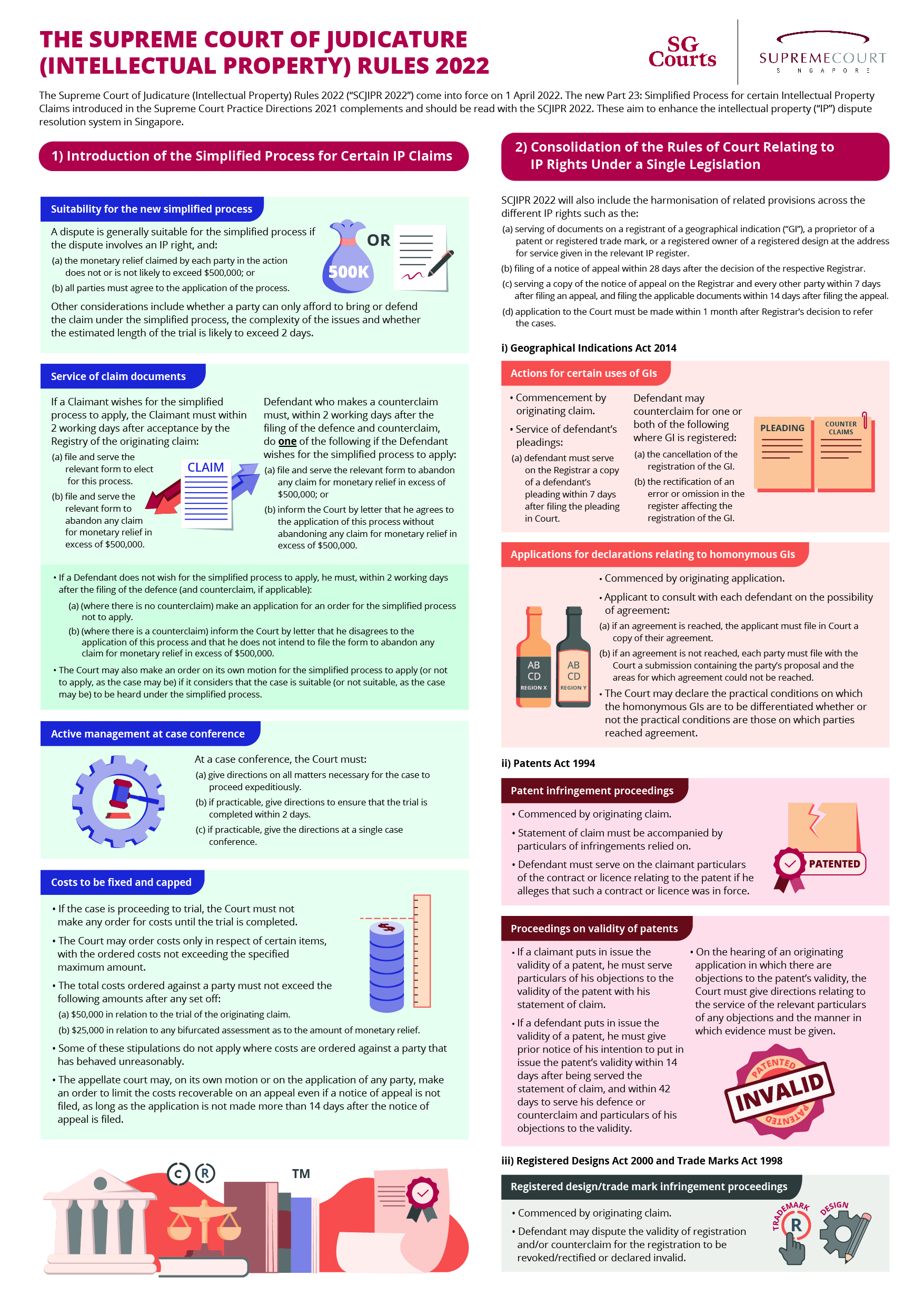New Legislation to enhance Intellectual Property Dispute Resolution
The new Supreme Court of Judicature (Intellectual Property) Rules 2022 (“SCJIPR 2022”) have come into force on 1 April 2022. It will enhance the intellectual property (“IP”) dispute resolution system by making it more accessible to individuals and companies, particularly small and medium-sized enterprises. It will also position Singapore as a choice venue for IP dispute resolution in Asia with a strong body of IP jurisprudence.
2 SCJIPR 2022 finds its origin in the recommendations put forth in the Final Report of the Intellectual Property Dispute Resolution (“IPDR”) Framework Review Committee, which was appointed by the Ministry of Law (“MinLaw”) in 2015 to review Singapore’s IP dispute resolution framework. A public consultation was thereafter conducted in October 2018 to gather feedback on the proposed reforms to the IP dispute resolution system.
Consolidation of most civil IP cases in the High Court
3 A key feature of the proposed reforms was the consolidation of most civil IP cases in the High Court, thereby simplifying the current system where they are heard in multiple fora. Presently, IP disputes may be heard in the High Court, State Courts or Intellectual Property Office of Singapore (“IPOS”), depending on the nature of the IP right, the type of proceeding or the value of the claim.
4 The Intellectual Property (Dispute Resolution) Act 2019 (“IPDR Act 2019”) was enacted to implement, among other things, this feature. The relevant provisions which come into force on 1 April 2022 will amend several IP-related legislation, as well as the State Courts Act, to grant the High Court exclusive jurisdiction over most civil IP disputes, such as infringement of all forms of IP and passing off. This simplifies the current system.
5 In a similar vein to the IPDR Act 2019, the SCJIPR 2022 consolidates the Rules of Court relating to IP rights in a single piece of legislation, makes amendments to implement obligations to notify the Registrar of Designs, Geographical Indications, Patents and Trade Marks, and harmonises related provisions across IP rights.
Simplified Process for Certain Intellectual Property Claims
6 A key recommendation from the review by the IPDR Framework Review Committee was to establish an optional track for IP litigation, which contains several features aimed at facilitating quicker and more cost-effective dispute resolution. A new single streamlined procedure will ensure time and cost proportionality for IP disputes. The aim is to enable less well-resourced parties who may otherwise be unable to enforce their IP rights or defend themselves in litigation, to be able to do so.
7 This new optional track is to be implemented through the SCJIPR 2022 as the Simplified Process for Certain Intellectual Property Claims (“Simplified Process”). The key features of the Simplified Process are as follows:
- It is generally suitable if the dispute involves an IP right, where the monetary relief claimed by each party in the action does not or is not likely to exceed $500,000 or where all parties agree to the application of the process.
- At a case conference, the court must give directions on all matters necessary for the case to proceed expeditiously and, if practicable, give directions to ensure that the trial is completed within 2 days.
- If the case is proceeding to trial, the total costs ordered against a party must not exceed $50,000 in relation to the trial of the originating claim, and must not exceed $25,000 in relation to any bifurcated assessment as to the amount of monetary relief after any set off.
8 The introduction of the Simplified Process creates a nuanced two-track approach that may accommodate the different priorities of court users. It will leave largely unchanged a ‘normal track’, where proceedings can continue to be conducted in essentially the same way as is currently available.
9 A “transitional learning phase” from 1 April to 30 June 2022, which applies to the Rules of Court 2021, will likewise apply to the SCJIPR 2022.
10 Welcoming the implementation of the SCJIPR 2022, Chief Justice Sundaresh Menon said, “With IP registrations growing steadily in Singapore over the years, having a robust dispute resolution and enforcement framework for IP disputes is critical. In particular, it is essential that IP rights-holders have access to a speedy and cost proportionate mechanism to enforce such rights. The SCJIPR 2022, which introduces this mechanism, is a landmark development in the evolution of Singapore’s IP dispute resolution system, and will significantly strengthen our position as an IP hub in Asia.”
11 Please refer to the Infographics enclosed in the ANNEX for the key highlights of SCJIPR 2022.

ISSUED BY:
SUPREME COURT OF SINGAPORE AND MINISTRY OF LAW
5 April 2022








